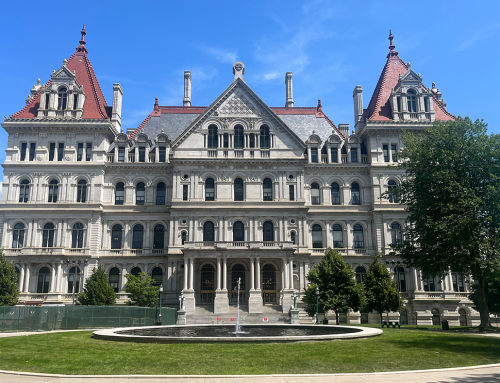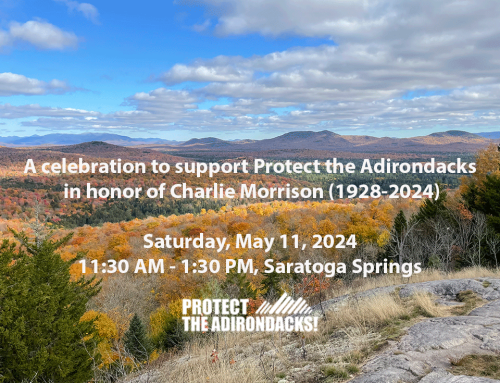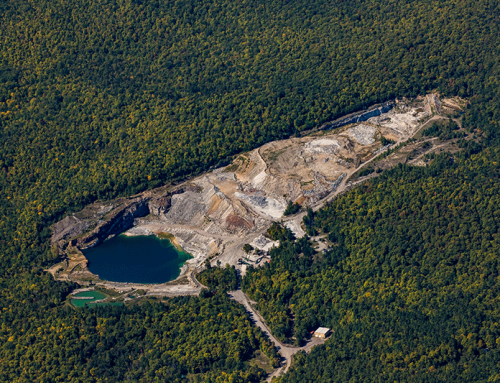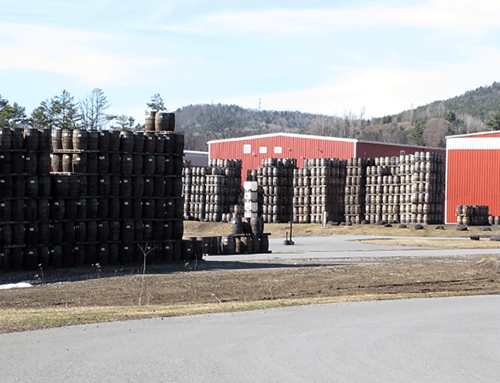July 8, 2015
Hon. Lani Ulrich, Chair
NYS Adirondack Park Agency
PO Box 99
Ray Brook, NY 12977
RE: Public Comment on Proposed Community Connector Trail UMPÂ Amendments
Dear Chairwoman Ulrich,
We respectfully submit these comments, timely in accordance with the Adirondack Park Agency’s (APA) policy concerning their submission, and request that you be so kind as to provide copies to APA members and involved staff prior to tomorrow’s meeting. These comments focus on three important issues involved in the APA’s deliberations and possible actions on the Proposed Community Connector Trail UMP Amendments.
Community Connector Trail UMP Amendments Threaten Quality of Life of Private Landowners Whose Lands are Targeted by Major New Snowmobile Trails
Protect the Adirondacks has been contacted by a number of private landowners whose property, without any consultation whatsoever with them, has shown up on various state maps as locations for major new snowmobile trails from Newcomb to North Hudson or Newcomb to Minerva as part of the proposed Community Connector Trail UMP Amendments. These landowners stand forcefully united in their opposition to these trails. One affected landowner in North Hudson deliberately purchased his property, surrounded by Forest Preserve, and in one of the most remote parts of the Adirondacks, to escape the snowmobile noise and pollution he encountered in Inlet where he grew up. To his dismay he has found that DEC has charted, without any notice to him, a major class II community connector trail through his lands. How tragic. It is unacceptable for the APA to ignore the comments of these families. Should the APA pass a resolution approving the Community Connector Trail UMP Amendments its resolution must not allow any piecemeal construction of them absent documented agreement on the part of the landowners involved that their lands may be used for such trails.
Community Connector Trails Proposed by DEC Violate the Wild, Scenic and Recreational Rivers Act and DEC Regulations at 6 NYCRR Part 666
The APA staff memo prepared for the July 9, 2015 meeting is incomplete with regards to compliance of actions in the proposed Community Connector Trail UMP Amendments with the Wild, Scenic and Recreational Rivers Act (WSRRA). Important issues are not addressed. The staff memo stated:
Comments made regarding the WSRRA were specific to the Boreas River crossing at NYS Route 28N (designated as Scenic) where it flows through State lands. The Department’s River regulations apply on State lands. (APA’s river regulations apply only to private lands in the Park). While certain guidelines and criteria of the APSLMP do pertain to the WSRRS and Scenic Rivers on State lands, the basic guideline for Scenic Rivers in the APSLMP is that they will be managed in accordance with the guidelines and criteria for lands classified as Wild Forest. In Wild Forest areas, snowmobile trails with bridges are allowed.
This narrow reading of the State Land Master Plan (SLMP) ignores the APA’s duty under the statutes it administers. Yes, the SLMP states that Scenic River corridors are to be managed as, in essence, Wild Forest areas, which allow motorized uses. But, most importantly, it ignores a number of critical legal issues that it must confront with regard to allowable uses in Scenic River corridors.
Just as the APA Act directs the APA to promulgate regulations for State lands through the State Land Master Plan, the Environmental Conservation Law directs the DEC to develop regulations for the WSRRA. DEC WSRRA Regulations at 6 NYCRR Part 666.4 states “Management of scenic river areas will be directed to preserving and restoring their natural scenic qualities.” We question how construction of a snowmobile trail and bridge across the Boreas River through a trailless and wild part of the Vanderwhacker Mountain Wild Forest area meets the requirement to preserve and restore “their natural scenic qualities.”
Of paramount importance, in order to make its legally required determination that the DEC submission before you complies with the SLMP, the APA must determine that it complies with the WSRRA itself. The SLMP prohibits any management of river areas less restrictive than that allowed by the WSRRA itself. On this point of conflicting regulations, the APA has chosen the path of least restriction, which is incorrect.
Article 27, Section 15-2721 of the Environmental Conservation Law, which governs the WSRRA, states:
§ 15-2721. Conflict with other laws.
Any section of the state wild, scenic and recreational rivers system that is or shall become a part of the Forest Preserve, the Adirondack or Catskill Parks or any other state park, wildlife refuge, or similar area shall be subject to the provisions of this title, and the laws and constitutional provisions under which the other areas may be administered, and in the case of conflict between the provisions of those laws and constitutional provisions and the provisions of this title, the more restrictive provisions shall apply.
The APA takes the position, as referenced above, that a Scenic River corridor should be managed no differently than Wild Forest lands. This interpretation appears to violate the WSRRA, as quoted above, because DEC Regulations at 6 NYCRR Part 666.3 Definitions states: ” ‘Trail’ means a marked and maintained path or way four feet or less in width, and located and designed to provide for reasonable access in a manner causing the least effect on the local environment.”
The APA staff memo prepared for the July 9, 2015 meeting states:
In 2009, the Adirondack Park Agency formally reviewed and approved – as conforming to the relevant guidelines and criteria of the APSLMP – the “Management Guidance: Snowmobile Trail Siting, Construction and Maintenance on Forest Preserve Lands in the Adirondack Park” (Guidance). The Guidance prescribes DEC’s current snowmobile trail development and maintenance practices, considers snowmobiles’ potential impacts and is being implemented in this Plan. Specifics for each of the trails proposed in the Plan will be identified and follow the Guidance, in Work Plans submitted by the Department for Agency review, thus enabling staff another opportunity to ensure impacts are minimized.
Therefore, the APA has determined that 9-11 foot wide class II community connector snowmobile trails in Wild Forest areas are lawful under the “Guidance” referenced above, in stark conflict with DEC’s 6 NYCRR 666 implementing regulations. In situations of such conflict the WSRRA requires that the more restrictive requirement should prevail, which in this case would be 4 feet versus 9-11 feet. PROTECT is at a loss to understand how the APA can approve a trail more than twice the width of what is allowable under DEC Regulations 6 NYCRR Part 666 and comply with the “more restrictive” requirement of the WSRRA.
There is further evidence for the intent of the DEC Regulations 6 NYCRR Part 666 for the 4-foot trail requirement. The DEC’s Environmental Impact Statement (EIS) promulgated at the time of adoption of these regulations in 1986 shines additional light on DEC’s prohibitions and limitations for management of Scenic River corridors. In its “Public Response” section, the EIS states:
The Regulations have been amended to prohibit motorized open space recreational uses in scenic river areas. Therefore, bridges for this use have been prohibited. (Page 57)
The Department agrees that motorized recreational vehicles should not be allowed to operate in scenic river areas due to their relatively undeveloped nature and the concurrent extensive low intensity recreational and other passive outdoor uses which predominately take place within such river areas and conflict with motorized recreational vehicles. (Page 58)
A maximum width of four feet has been established for foot trails. This will assist in precluding inappropriate motorized uses on such trails and prevent designation of roads as foot trails. (Page 31)
Note that the EIS states such types of motorized bridges can be created in Recreational River areas.
It is manifestly clear that the only way that a major class II community connector trail can lawfully be built in the Boreas River Scenic Corridor, or build a bridge for motorized recreation over the Boreas River, is for the Legislature to change the WSRRA classification from Scenic to Recreational, otherwise amend the WSRRA, or for the DEC to change 6 NYCRR Part 666.
APA Must Reject DEC’s River Area Management Plan for the Boreas River Scenic River Area
The DEC states that the Community Connector Trail Plan also constitutes a River Area Management Plan (RAMP) for the Boreas River, classified as a Scenic River. Moreover, DEC’s 1986 FEIS on adopting 6 NYCRR Part 666 states in this regard that the principal purpose for developing a RAMP is for management of a classified river area/corridor in a way that is more restrictive, and provides even greater protections, than that accorded under solely under 6 NYCRR Part 666. The fundamental purpose of a RAMP is to strengthen protections – not weaken them. DEC’s proposed RAMP for the Boreas River seeks to weaken protections under both the WSRRA and 6 NYCRR Part 666.
The EIS states: “After designation and establishment of boundaries for a river area, management plans may be drawn up and River specific regulations promulgated as necessary. Both the management plan and the river specific regulations must be at least as restrictive as the statewide regulations and must conform to the umbrella of authority afforded by the act” (Page 40). Further, the EIS states “management plans control river specific actions and in no way provide relief or relaxation of the provisions contained in statewide regulations. Management plans can only recommend more stringent controls than those contained in the Statewide regulations” (Page 39). 6 NYCRR Part 666 details six criteria for RAMPs.
In this case, the DEC is trying to use its development of a RAMP for the Boreas River to weaken, rather than strengthen, protections. The construction of a new class II community connector trail and bridge of 9-11 feet in width are far more damaging to the natural resources and scenic qualities of the classified Boreas River corridor than a 4-foot wide trail required under the DEC regulations. In no way does the mere existence of a RAMP for the Boreas River somehow allow the APA and DEC to approve uses – a motor vehicle bridge and trail greater than four feet in width – that are otherwise prohibited by DEC regulations.
Class II Community Connector Snowmobile Trails Violate State Law
It would be much more accurate for the APA to state that these amendments are solely for proposed class II community connector snowmobile trails and drop the pretense that these are multi-use trails. In fact, these road-like, class II community connector snowmobile trails are not built this way to facilitate hiking, mountainbiking, horseback riding, or cross-country skiing. No other recreational use in the Forest Preserve requires 9-11 foot wide trails. Class II community connector snowmobile trails are specifically designed and constructed to allow regular grooming with large multi-ton motor vehicles and high speed snowmobile travel. Unlike other trails built by hand, these trails are excavated with heavy machinery, utilize extensive bench cutting, remove thousands of trees over 3 inches diameter at breast height (DBH), remove tens of thousands of trees under 3 inches DBH, remove the entire native understory, often replace the native understory with a grass mix, open the forest canopy, often fracture and chip away bedrock, utilize oversized bridges often equipped with reflectors, and are built to handle operation of motor vehicles. No other recreational activity in the Forest Preserve, outside of Intensive Use Areas, requires such profound terrain alteration and destruction of natural resources. Protect the Adirondacks believes that this network of “trails” violates the SLMP and Article XIV, Section 1 of the NYS Constitution.
Conclusion
For all the reasons stated above, Protect the Adirondacks does not believe that the APA can lawfully approve the proposed Community Connector Trail Plan at its July 9, 2015 meeting. In order for the APA to make its legally required determination that the DEC submission before you complies with the SLMP, the APA must determine that it complies with the WSRRA itself. The SLMP prohibits any management of river areas less restrictive than allowed by the WSRRA.The APA cannot simply review the decision of SLMP compliance of a proposed new trail and bridge over the Boreas River through analysis-in-a-vacuum that ignores DEC’s 6 NYCRR Part 666 regulations as well as the WSRRA. We call upon to the APA to reject this plan and send it back to the DEC for revision in order to comply with the WSRRA.
On behalf of the Board of Directors of Protect the Adirondacks, please let me express our gratitude for the opportunity to submit these comments.
Sincerely,
Peter Bauer
Executive Director
Click here to read PROTECT’s letter to the APA. Click here to read the press release.





